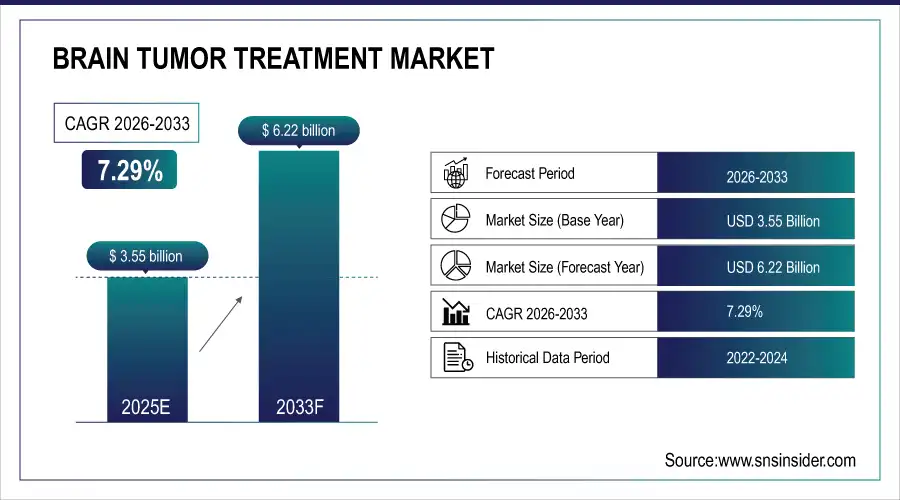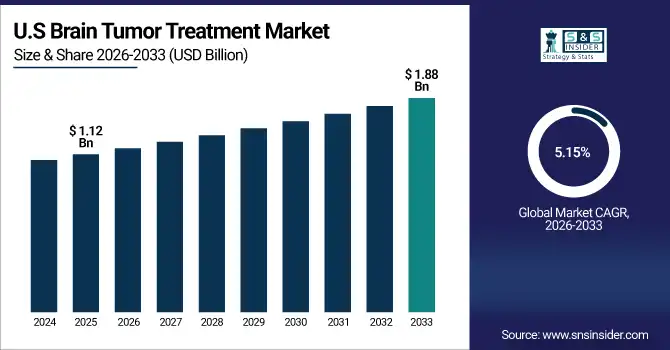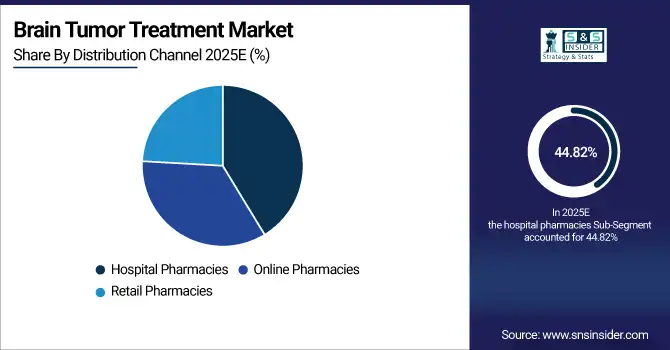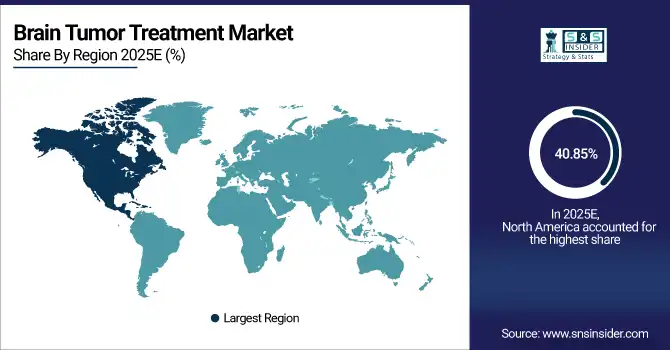Brain Tumor Treatment Market Report Scope & Overview:
The global brain tumor treatment market size was valued at USD 3.55 billion in 2025E and is projected to reach USD 6.22 billion by 2033, growing at a CAGR of 7.29% during the forecast period 2026–2033.
The brain tumor treatment market is expanding rapidly due to rising prevalence of brain cancers, technological advances in imaging, and adoption of targeted therapies. Increasing demand for minimally invasive operations and immunotherapy is changing practices. With 700,000 patients affected annually across the globe, there is a large market potential in hospitals, specialty clinics and research centers. Growing advances in oncology research and development, expanded access through hospital and online pharmacy systems are propelling new growth.
Around 60% of brain tumor patients undergo surgery, while targeted therapies and immunotherapies are rapidly gaining adoption.
Market Size and Forecast:
-
Market Size in 2025: USD 3.55 Billion
-
Market Size by 2033: USD 6.22 Billion
-
CAGR: 7.29% from 2026 to 2033
-
Base Year: 2025
-
Forecast Period: 2026–2033
-
Historical Data: 2022–2024

To Get more information On Brain Tumor Treatment Market - Request Free Sample Report
Brain Tumor Treatment Market Trends:
-
The pace of targeted therapy adoption is increasing, and use will account for 28% of all treatments by 2026.
-
Use of immunotherapy is increasing consistently, and 25% more patients are expected to take on the therapy in 2026-28.
-
Clinical trials are solid and over 480 global studies still active in 2025 investigating new drug classes and combinations.
-
Distribution trends are changing, as online pharmacy sales of cancer drugs are projected to expand by 18% in 2026.
-
Market innovation persists with 35% of the best pharma companies expected to launch new treatments for brain tumors by 2027.
U.S. Brain Tumor Treatment Market Insights
The U.S. brain tumor treatment market was valued at USD 1.12 billion in 2025E and is projected to reach USD 1.88 billion by 2033, growing at a CAGR of 5.15% during 2026–2033. This growth is fueled by over 250,000 annual brain tumor diagnoses, a high volume of clinical trials, and rapid FDA approvals. Strong reimbursement frameworks and the presence of major pharma players accelerate adoption of targeted and immunotherapies, cementing U.S. leadership.

Brain Tumor Treatment Market Growth Drivers:
-
Rising Incidence of Brain Tumors Fuels Demand, with Patients Diagnosed Annually Driving Expansion of Advanced Treatment Options.
Increasing prevalence of brain tumors with more than 700,000 patients annually is the most significant factor stimulating market growth. There is an urgent need to develop effective treatments for the rising rates of diagnosis, driving surgical advances and targeted medicines and immunotherapies. This tendency is strengthened as a result of healthcare investments and government efforts to enhance cancer treatment. Therefore, the market for brain tumor treatment is ripe for continued growth based on innovation and access.
In 2025, nearly 46% of brain tumor patients received targeted or immunotherapy-based treatments, making it one of the fastest-growing segments in oncology care.
Brain Tumor Treatment Market Restraints:
-
High Treatment Costs Restrain Market Growth, with Advanced Brain Tumor Therapies Often Exceeding Per Patient Annually.
High cost of treatment is a significant barrier hindering the brain tumor treatment market. Next-generation treatments i.e., targeted drugs and immunotherapies may cost over USD 120,000 per patient yearly, making them inaccessible to many. Surgery and radiation alone cost from USD 40,000 to 70,000 per patient, exerting a financial burden even when insurance covers it. In low- and middle-income countries, reimbursement restrictions and disparities in access further compound the issue. Affordability walls are limiting mass uptake, and market growth is being stunted along with increasing patient requirement.
Brain Tumor Treatment Market Opportunities:
-
Expanding R&D in Targeted Therapies Creates Major Opportunities, with Active Clinical Trials Worldwide Focused on Brain Tumor Treatments.
Growing R&D of targeted therapies is a major opportunity in brain tumor treatment market. Pharmaceutical and biotechnology companies are investing significantly to develop precision medicines that increase survival rates while minimizing side effects, with more than 480 active global clinical trials in 2025. In 2024 alone, the FDA approved 15 new oncology drugs, emphasizing the speed of innovation. When success rates are greater than approximately 30% in targeted therapy trials, this sector has the potential to yield substantial commercial and clinical value.
Over 55% of oncology patients are willing to choose costly targeted or immunotherapy options, boosting demand for advanced brain tumor treatments.
Brain Tumor Treatment Market Segmentation Analysis:
-
By Treatment Type, Volume Spread tracing to Surgery in 2025E holds a share of 35.42% and Immunotherapy records the fastest growth at CAGR of 9.54%.
-
By Tumor Type, glioblastoma is the leading category in 2025E with a share of 40.16%, and pituitary tumors expand at the highest CAGR of 8.24%.
-
By Drug Class, alkylating agents dominate with 32.44% share in 2025E, and targeted therapy drugs increase at the fastest CAGR of 9.11%.
-
By End User, hospitals hold 50.38% share by 2025E with specialty clinics to grow fastest at CAGR of 8.01%.
-
By Distribution Channel, hospital pharmacies account for 44.82% in 2025E, followed by Online Pharmacies growing at a CAGR of 9.32%.
By Treatment Type, Surgery Dominates While Immunotherapy Grows Rapidly:
Surgery is the main modality of treatment for brain tumor, as almost 72% of operable brain tumors are addressed initially by surgery. Its rapid reduction of tumor mass and superiority concerning survival makes it the agent of first choice. Immunotherapy is growing the most swiftly, with over 160 ongoing clinical trials worldwide in 2025 on checkpoint inhibitors and CAR-T therapies. Many of these treatments are demonstrating up to 35% progression-free survival benefit in certain subgroups resulting in aggressive uptake.
By Tumor Type, Glioblastoma Dominates While Pituitary Tumors Grow Rapidly:
Glioblastoma is the lead and accounts for approximately 47% of all malignant primary brain tumors worldwide, with an estimated 13,000 new cases per year in the U.S. The high rate of its aggressive behavior, recurrence as well as relatively low survival results necessitate a strong demand for multi-modal treatments. Pituitary tumours are going up even faster, with a rise of almost 28 per cent over the past decade thanks to increased MRI detecting. The effect of these on hormone control also underlies the demand for treatment.
By Drug Class, Alkylating Agents Dominate While Targeted Therapy Grows Rapidly:
Alkylating agents are still the most commonly used chemotherapeutic, as 80% of glioblastoma treatment protocols around the world recommend temozolomide as standard of care. Its high prevalence despite resistance and low cost with a proven clinical experience continue to keep it in the spotlight. Precision drugs are the fastest-rising, with strong global oncology R&D investment for targeted therapies. Approval of agents like bevacizumab and tumor-specific kinase inhibitors, which are changing treatment paradigms, elevates the sector.
By End User, Hospitals Dominate While Specialty Clinics Grow Rapidly:
Hospitals lead with over 68% of brain tumor surgeries and radiotherapies performed in hospitals across the globe owing to infrastructure, and a multi-disciplinary team of oncology service. This expertise gradient keeps hospitals as the central treatment hubs. By end user, the fastest growing specialty clinics are and the number of dedicated neuro-oncology centers increased by 33% worldwide between 2018 and 2024. There is an increasing demand among patients to receive specialist, ambulatory-based treatment without the need for surgery.
By Distribution Channel, Hospital Pharmacies Dominate While Online Pharmacies Grow Rapidly:
The hospital pharmacies are the main drivers of distribution as roughly 72% of these oncology drugs, including expensive brain tumor treatments, are distributed through subsidized units for better reporting and compliance. Their tie-in with treatment centers provides leadership. E-pharmacies are gaining the most ground with online pharmacies growing at a 21% YoY increase in oncology-related sales across key markets by 2024. For patients, proximity, home visits and larger insurance tie-ups are making them choose digital platforms instead of traditional ones, especially in urban areas.

Brain Tumor Treatment Market Regional Analysis:
North America Brain Tumor Treatment Market Insights:
North America dominates the brain tumor treatment market with 40.85% share in 2025E, supported by advanced healthcare infrastructure, high awareness, and strong access to innovative therapies. The U.S. has more than 310,000 annual cases of brain and other central nervous system cancers so there is strong demand for treatment options. Swift approvals by the FDA, positive reimbursement structures and presence of major pharmaceutical companies will drive quicker uptake of targeted and immunotherapies to continue driving market dominance in the region.

Get Customized Report as per Your Business Requirement - Enquiry Now
U.S. Brain Tumor Treatment Market Insights:
The U.S. brain tumor therapeutics market is advantaged by 42% of global oncology R&D investment and more than 210 clinical trials being active in the year 2025. Innovation and advanced care solidify U.S. leadership, with 68% of cancer centers integrating proton beam and radio-surgery technology into treatments and a 14% increase in five-year survival rates.
Asia-Pacific Brain Tumor Treatment Market Insights:
The Asia-Pacific brain tumor treatment market is set to expand at a CAGR of 8.72%, making it the fastest-growing region globally. The growth is due to an increasing incidence of over 120,000 new brain tumor cases per year, growing healthcare expenditures and a surge in advanced treatments. Growing healthcare infrastructure government investment and increasing access through e-health and medical tourism, are also driving adoption at a faster rate, making Asia-Pacific the fastest growing region during forecast period.
China Brain Tumor Treatment Market Insights:
China leads the Asia-Pacific brain tumor treatment market with over 45,000 new cases reported each year. Growth is also fueled by the addition of oncology hospitals, adoption of advanced therapies, and clinical trial activity which underpins China as the regional hub for treatment innovation.
Europe Brain Tumor Treatment Market Insights:
Europe is a critical region in the brain tumor treatment market, with over 114,000 active patients under treatment and 2,600+ ongoing clinical trials advancing innovation. Strong national healthcare systems mean more than 92% of high-grade glioma adult patients have access to targeted agents, particularly in Germany, the UK France and Italy. Strong EU investment in oncology research and partnerships with global pharma support the region’s position, positioningEurope as a centre of excellence foradvanced brain tumor care and treatment innovation.
Germany Brain Tumor Treatment Market Insights:
Germany is the dominant player in the European brain tumour treatment market with more than 15,000 new cases every year and 542 clinical trials which represent a share of almost 21% of Europe’s overall research. Modern oncology centers, significant R&D spend and universal insurance coverages also guarantee installing the treatment very fastly.
Latin America Brain Tumor Treatment Market Insights:
Latin America’s brain tumor treatment market is expanding, fueled by improving healthcare access and oncology investments. Brazil carries out more than 12,000 neurosurgeries per year, serving a major role in regional healthcare. In addition to Mexico’s expansion of targeted therapies, more clinical trial collaborations are expanding access to new treatments and establishing Latin America as an emerging growth market.
Middle East and Africa Brain Tumor Treatment Products Market Insights:
The Middle East & Africa brain tumor treatment market is advancing with growing access to specialized oncology services. In 2025, there are more than 220 active brain tumor clinical trials in the region, indicating an increasing participation in research. Investing in new, state-of-the-art radiotherapy facilities; particularly in UAE and Saudi Arabia is increasing treatment provision opportunities also further driving long-term growth.
Brain Tumor Treatment Market Competitive Landscape:
Roche leads the global brain tumor treatment market in 2025 with 150+ active oncology trials, including multiple glioblastoma-specific programs. Its large bet on bimarker-based treatments and immuno-oncology means it is targeting with precision, leading to better care for patients. Supported by the world’s largest oncology pipeline and a growing network of high-quality international partnerships, Roche continues to demonstrate the most extensive clinical presence. Such unparallel research base and early use of targeted drugs is strengthening its reign on European market as well as global markets.
-
In June 2025, Roche expanded its clinical research program with new trials investigating targeted therapies for glioblastoma, aiming to improve survival outcomes in aggressive brain tumors.
Novartis ranks second, supported by 120+ ongoing brain tumor-related trials and a diverse oncology portfolio spanning kinase inhibitors, immunotherapies, and CAR-T treatments. Through partnerships with more than 60 academic and hospital research centers globally, Novartis is hastening drug testing and approval. Its top-notch precision medicine approach results in a high treatment success rate, making Novartis one of the fastest rising competitors. Novartis is also catching up with Roche, which has a strong clinical uptake across Europe and the Asia-Pacific.
-
In July 2025, Novartis received FDA approval for Afinitor® (everolimus) to treat subependymal giant cell astrocytoma (SEGA), a rare benign brain tumor in patients not eligible for surgery.
Pfizer holds the third spot in 2025, reaching over 2 million oncology patients globally, with a focus on combination therapies and immunotherapies for brain tumors. It operates more than 90+ active trials treating brain cancers and has partnerships with top academic centers to speed innovation. Its depth of brain tumor–specific drugs is not quite that of Roche or Novartis, but Pfizer’s sheer global scale, R&D pipeline and patient access also guarantee it one of the top three leadership positions.
-
In August 2025, Pfizer faced over 500 U.S. lawsuits alleging its Depo-Provera contraceptive injection increased risk of meningiomas, highlighting growing safety scrutiny in brain tumor–related cases.
Brain Tumor Treatment Market Key Players:
Some of the Brain Tumor Treatment Market Companies are:
-
Roche (F. Hoffmann-La Roche)
-
Novartis AG
-
Pfizer Inc.
-
Merck & Co., Inc.
-
Bristol-Myers Squibb
-
AstraZeneca
-
Bayer AG
-
Eisai Co., Ltd.
-
Amgen Inc.
-
Johnson & Johnson
-
AbbVie Inc.
-
Celldex Therapeutics
-
Novocure Ltd.
-
Antisense Pharma
-
Dr. Reddy’s Laboratories
-
Mankind Pharma
-
Daiichi Sankyo Co., Ltd.
-
BeOne Medicines (formerly BeiGene)
-
Teva Pharmaceutical Industries
-
DelMar Pharmaceuticals
| Report Attributes | Details |
|---|---|
| Market Size in 2025 | USD 3.55 Billion |
| Market Size by 2033 | USD 6.22 Billion |
| CAGR | CAGR of 7.29% From 2026 to 2033 |
| Base Year | 2025 |
| Forecast Period | 2026-2033 |
| Historical Data | 2022-2024 |
| Report Scope & Coverage | Market Size, Segments Analysis, Competitive Landscape, Regional Analysis, DROC & SWOT Analysis, Forecast Outlook |
| Key Segments | •By Treatment Type (Surgery, Radiation Therapy, Chemotherapy, Targeted Therapy, Immunotherapy, Others) •By Tumor Type (Glioblastoma, Meningioma, Pituitary Tumors, Astrocytoma, Others) •By Drug Class (Alkylating Agents, Antimetabolites, Hormonal Agents, Others) •By End User (Hospitals, Specialty Clinics, Ambulatory Surgical Centers, Research & Academic Institutes) •By Distribution Channel (Hospital Pharmacies, Retail Pharmacies, Online Pharmacies) |
| Regional Analysis/Coverage | North America (US, Canada), Europe (Germany, UK, France, Italy, Spain, Russia, Poland, Rest of Europe), Asia Pacific (China, India, Japan, South Korea, Australia, ASEAN Countries, Rest of Asia Pacific), Middle East & Africa (UAE, Saudi Arabia, Qatar, South Africa, Rest of Middle East & Africa), Latin America (Brazil, Argentina, Mexico, Colombia, Rest of Latin America). |
| Company Profiles | Roche (F. Hoffmann-La Roche), Novartis AG, Pfizer Inc., Merck & Co., Inc., Bristol-Myers Squibb, AstraZeneca, Bayer AG, Eisai Co., Ltd., Amgen Inc., Johnson & Johnson, AbbVie Inc., Celldex Therapeutics, Novocure Ltd., Antisense Pharma, Dr. Reddy’s Laboratories, Mankind Pharma, Daiichi Sankyo Co., Ltd., BeOne Medicines (formerly BeiGene), Teva Pharmaceutical Industries, DelMar Pharmaceuticals |

